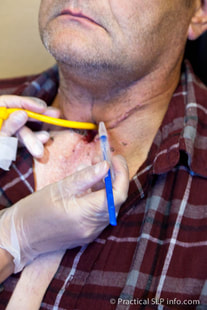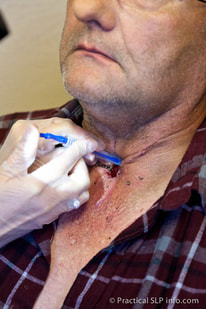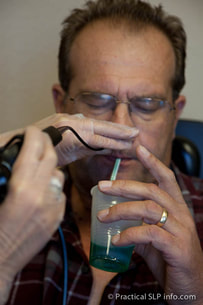When can I get a TEP?
In this practice, the TE puncture is created at the time of the laryngectomy surgery. After a period of sufficient healing, typically 2 weeks, the prosthesis is placed in the office. In the event you do not receive a TE puncture during your surgery, usually due to more extensive surgery or reconstruction, you will be punctured after a period of sufficient healing, typically around 3-4 months after surgery.
How do I clean my voice prosthesis?
Why do I need to use both a brush and a flush when cleaning my voice prosthesis?
When using the brush to clean, followed by the flush, you are performing a similar process as when you use a toothbrush to clean your teeth and then rinse. The brush is effecting in loosening the debris while the flush ensures it is all rinsed well away.
How often do I clean my voice prosthesis?
In this practice, we recommend cleaning twice a day. Once in the morning and once in the evening. You may also clean it, as needed during the day in the event it may not be functioning properly. You may find it helpful to clean it after each meal to assist with removing food debris that may be present. Following the instructions detailed in Cleaning Your Voice Prosthesis.
Is it normal for my voice prosthesis
to spin in place?
Yes! It is normal for the voice prosthesis to rotate within the TE tract and usually indicates a healthy tract. You should not be alarmed if you notice this.
Is it normal for my voice prosthesis to stick out further than it used to?
During the first 12 months following a laryngectomy, the healing process that evolves may also result in the TE party wall (the segment of tissue where the voice prosthesis is placed) thinning somewhat. There may also be changes to the location of the prosthesis or the angle in which it is sitting. Generally speaking, these are normal changes that occur during the recovery process over the first 12 months.
As the TE party wall thins, the prosthesis may now appear to be too long. Although the prosthesis is fitted to sit well within the party wall, extra length may not necessarily be a problem.
In this practice, a prosthesis that appears long will not be changed unless:
1. There is leakage around the outside of the prosthesis.
2. It is interfering with your ability to swallow.
3. It is interfering with your ability to speak.
If you believe your prosthesis is too long and is giving you a problem in this regard, contact the SLP staff and they can further evaluate and manage.
When does my voice prosthesis need
to be changed?
A voice prosthesis needs to be changed when it is no longer functional. The most common reason to change a voice prosthesis is due to leakage through the center of the prosthesis that occurs when the valve is no longer able to seal properly, allowing liquids from the esophagus to pass into the trachea during swallowing.
Although this is the most common reason, there can be other indications for prosthesis replacement. Before you determine if your voice prosthesis should be changed, refer to Troubleshooting Voice Prosthesis Issues.
What do i do when my voice prosthesis leaks?
You should first determine if the leakage is coming through the center of the prosthesis or from around the outside of the prosthesis. This can be done by drinking a colored beverage (not red) and watching when the leakage occurs.
If the leakage is coming from around the prosthesis, you should contact the SLP department for further assistance as soon as possible. See Preventing Aspiration.
You should first determine if the leakage is coming through the center of the prosthesis or from around the outside of the prosthesis. This can be done by drinking a colored beverage (not red) and watching when the leakage occurs.
If the leakage is coming from around the prosthesis, you should contact the SLP department for further assistance as soon as possible. See Preventing Aspiration.
It is not uncommon to experience intermittent leakage of the voice prosthesis. This is usually due to debris preventing a proper seal of the valve door and can typically be easily resolved by cleaning the prosthesis. See Cleaning Your Voice Prosthesis.
If, however, the leakage continues to occur repeatedly, even after cleaning, you need to seek SLP attention. See Preventing Aspiration.
If, however, the leakage continues to occur repeatedly, even after cleaning, you need to seek SLP attention. See Preventing Aspiration.
HOW CAN I PROLONG THE LIFE OF MY
VOICE PROSTHESIS?
|
There are many factors involved in how long a voice prosthesis lasts, most of which are largely uncontrollable. To allow for the best device life possible, it’s important to clean the prosthesis regularly. Eating yogurt cultures regularly is also suspected to improve device life by discouraging yeast growth on the prosthesis, which is typically the most common cause of TEP leakage. Flushing the device with Coca-Cola or drinking it daily have also been reported to improve device life with the theory that Coca-Cola may help prevent candida or yeast formation. |
More recent findings have suggested that reflux management has a big impact on device life. It is not uncommon for the speech pathology staff to prescribe reflux management protocols to assist with the function and life of the voice prosthesis.
Can I keep my voice prosthesis if I am going to have hyperbaric oxygen treatments?
Yes. The voice prosthesis can remain in place throughout the duration of your hyperbaric oxygen treatments.
What should I do if my voice prosthesis
falls out?
Although it is very rare that the indwelling-type prostheses we use in this practice will dislodge on their own, should this happen, it is important you:
1) Insert the "emergency catheter" given to you during one of your initial appointments with the SLP staff. This is a slim, rubber tube. Insert the rounded tip directly into the tract (the "hole" left by the missing TEP). Pass this at least 6 inches into your esophagus.
2) Contact the office immediately or seek attention at the Baylor All Saints ER.
3) Contact the office through this website to reach the SLP staff outside of normal office hours.
Why does my voicing “cut off” after
just a few words?
When producing speech using a TEP, the air travels through muscular passageway as it leaves the esophagus. For this reason, to much muscle tension in the region can cause your speech to “cut off” or be strained.
Ensuring you are relaxed, using your diaphragm to power your voice, while relaxing the throat muscles is the best way to ensure the best quality, continuous speech. In some cases, however, there can be involuntary muscle contraction in response to the airflow used to speak. In this case, the SLP staff can determine if further medical intervention is required to help you achieve your best voice possible.
Click here for Voicing Tips.
Can i use a handsfree device to speak?
Yes! There are devices engineered to allow hands-free speech. These, however, should be used once you are able to produce comfortable and reliable speech. The SLP staff can assist you in determining if a hands free device is appropriate for you.
Can i sleep with my freehands hme?
The FreeHands HME should ALWAYS be removed before sleeping. At bedtime, a FreeHands HME and a cap can be placed for sleeping. In many cases, however, patients may prefer to replace with a standard XtraMoist HME cassette as this provides for the most humidification during sleeping. DO NOT lock the device in the “off” position and assume this is appropriate for sleeping. The FreeHands device must always be removed for any periods of sleep, including napping.
For more information about Hands Free Speech, click here.
For more information about Hands Free Speech, click here.
Copyright 2011 Katrina Jensen





